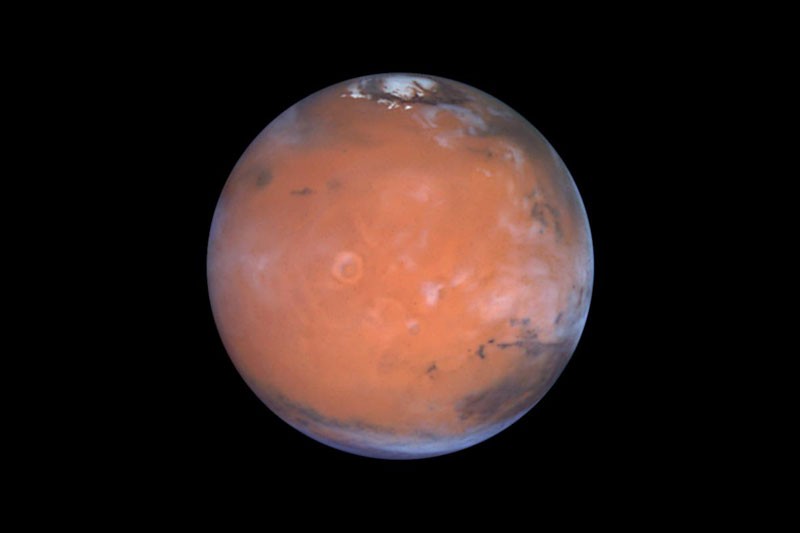The excitement over discovery hinting at potential microorganisms in the clouds of Venus hasn't subsided yet, as new discovery came in - multiple underground lakes on Mars!
Researchers have detected a group of lakes hidden under the red planet’s icy surface.

The discovery, reported on 28 September in Nature Astronomy, was made using radar data from the European Space Agency’s Mars-orbiting spacecraft, called Mars Express. It follows the detection of a single subsurface lake in the same region in 2018 — which, if confirmed, would be the first body of liquid water ever detected on the red planet and a possible habitat for life. But that finding was based on just 29 observations made from 2012 to 2015, and many researchers said they needed more evidence to support the claim. The latest study used a broader data set comprising 134 observations from 2012 to 2019.
“We identified the same body of water, but we also found three other bodies of water around the main one,” says planetary scientist Elena Pettinelli at the University of Rome, who is one of the paper’s co-authors. “It’s a complex system.”
The team used a radar instrument on Mars Express called the Mars Advanced Radar for Subsurface and Ionosphere Sounding (MARSIS) to probe the planet’s southern polar region. MARSIS sends out radio waves that bounce off layers of material in the planet’s surface and subsurface. The way the signal is reflected back indicates the kind of material that is present at a particular location — rock, ice or water, for example. A similar method is used to identify subsurface glacial lakes on Earth. The team detected some areas of high reflectivity that they say indicate bodies of liquid water trapped under more than one kilometre of Martian ice.
The lakes are spread over about 75,000 square kilometres — an area roughly one-fifth the size of Germany. The largest, central lake measures 30 kilometres across, and is surrounded by 3 smaller lakes, each a few kilometres wide.
On the surface of Mars, the low pressure that results from the planet’s
lack of a substantial atmosphere makes liquid water impossible. But
scientists have long thought that there could be water trapped under
Mars’s surface, perhaps a remnant of when the planet once had seas and
lakes billions of years ago. If such reservoirs exist, they could be
potential habitats for Martian life. On Earth, life is able to survive
in subglacial lakes in places such as Antarctica.
But the amount of salt present could pose problems. It’s thought that any underground lakes on Mars must have a reasonably high salt content for the water to remain liquid. Although this far beneath the surface there might be a small amount of heat from the interior of Mars, this alone would not be enough to melt the ice into water. “From a thermal point of view, it has to be salty,” says Pettinelli.
Lakes with a salt content that is about 5 times that of sea-water can support life, but as the concentration approaches 20 times that of sea-water, life is no longer present, says John Priscu, an environmental scientist at Montana State University in Bozeman.
“There’s not much active life in these briny pools in Antarctica,” says Priscu, whose group studies microbiology in icy environments. “They’re just pickled. And that might be the case [on Mars].”
The presence of the Martian lakes themselves is also still debated. After the 2018 discovery, researchers raised concerns such as the lack of an adequate heat source to turn the ice into water. And, although the latest finding supports the 2018 observation and involves much more data, not everyone is convinced that the identified regions are liquid water.
“If the bright material really is liquid water, I think it’s more likely to represent some sort of slush or sludge,” says Mike Sori, a planetary geophysicist at Purdue University in West Lafayette, Indiana.
Jack Holt, a planetary scientist at the University of Arizona in Tucson, says that although he thinks the latest data are fine, he isn’t sure about the interpretation. “I do not think there are lakes,” says Holt, who is on the science team for the Mars Shallow Radar sounder (SHARAD) on NASA’s Mars Reconnaissance Orbiter. “There is not enough heat flow to support a brine here, even under the ice cap.”
A Chinese mission that is on its way to Mars might offer one way to check the claims. The Tianwen-1 mission will enter orbit in February 2021, and as well as deploying a rover onto the surface, the orbiter will carry a suite of scientific instruments. These include radar equipment that could be used to make similar observations. “Its capabilities are similar to MARSIS and SHARAD,” says David Flannery from the Queensland University of Technology in Brisbane, Australia.
For the time being, the prospect that these lakes are remnants of Mars’s wet past remains an exciting possibility. “There may have been a lot of water on Mars,” says Pettinelli. “And if there was water, there was the possibility of life.”
From: Nature